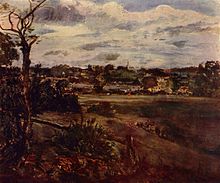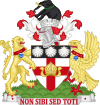This is an old revision of this page, as edited by 2.220.204.70 (talk) at 23:02, 18 July 2011 (grammar). The present address (URL) is a permanent link to this revision, which may differ significantly from the current revision.
Revision as of 23:02, 18 July 2011 by 2.220.204.70 (talk) (grammar)(diff) ← Previous revision | Latest revision (diff) | Newer revision → (diff) This article is on the London suburb. For other places see Highgate (disambiguation)| This article needs additional citations for verification. Please help improve this article by adding citations to reliable sources. Unsourced material may be challenged and removed. Find sources: "Highgate" – news · newspapers · books · scholar · JSTOR (May 2010) (Learn how and when to remove this message) |
| Highgate | |
|---|---|
 Highgate seen from Hampstead Heath Highgate seen from Hampstead Heath | |
| OS grid reference | TQ285875 |
| London borough | |
| Ceremonial county | Greater London |
| Region | |
| Country | England |
| Sovereign state | United Kingdom |
| Post town | LONDON |
| Postcode district | N6 |
| Dialling code | 020 |
| Police | Metropolitan |
| Fire | London |
| Ambulance | London |
| UK Parliament | |
| London Assembly | |
Highgate (/ˈhaɪɡeɪt/ or /ˈhaɪɡt/) is an area of North London on the north-eastern corner of Hampstead Heath.
Until late Victorian times it was a distinct village outside London, sitting astride the main road to the north. The area retains many green expanses including the eastern part of Hampstead Heath, three ancient woods, Waterlow Park and the eastern-facing slopes known as Highgate bowl.
At its centre is Highgate village, a collection of largely Georgian shops, pubs, restaurants and residential streets, interspersed with diverse landmarks such as St Michael's Church and steeple, Highgate School (1565), Jacksons Lane arts centre housed in a Grade II listed former church, the Gatehouse inn dating from 1670 and Berthold Lubetkin's 1930s Highpoint buildings. Highgate is also famous for its atmospheric Victorian cemetery in which the communist philosopher Karl Marx is buried.
The village sits atop a hill which provides views across London, climbing 375 feet (114 m) above sea level at its highest point.
Highgate is one of the most expensive London suburbs in which to live. It has an active conservation body, the Highgate Society, to protect its character.
The area is divided between three London boroughs: Haringey in the north, Camden in the south and west, and Islington in the south and east. The postal district is N6.
History

Historically, Highgate adjoined the Bishop of London's hunting estate. The Bishop kept a toll-house where one of the main northward roads out of London entered his land. A number of pubs sprang up along the route, one of which, the Gatehouse, commemorates the toll-house.
In later centuries Highgate was associated with the highwayman Dick Turpin.
Hampstead Lane and Highgate Hill contain the red brick Victorian buildings of Highgate School and its adjacent Chapel of St Michael. The school has played a paramount role in the life of the village and has existed on its site since its founding was permitted by letters from Queen Elizabeth I in 1565.
The area north of the High Street and Hampstead Lane was part of Hornsey parish and also later the Municipal Borough of Hornsey and the seat of that borough's governing body for many years.
Highgate Hill, the steep street linking Archway and Highgate village, was the route of the first cable car to be built in Europe. It operated between 1884 and 1909.
Notable inhabitants
Recent and current inhabitants of Highgate include Tariq Ali, Stanley Baxter, Arthur Boyd, Sir Jacob Bronowski, Pierce Brosnan, Sir Clifford Curzon, Ray Davies, Roger Fry, Stephen Gately, Stella Gibbons, Terry Gilliam, Freddie Highmore, Bob Hoskins, Terry Jones, Ulrika Jonsson, Judge Jules, David Ryan Jordan (Air Traffic), Jude Law and Sienna Miller, Marina Diamandis, Yehudi Menuhin (and later Sting who bought Menuhin's old house), Ewan Mcgregor, George Michael, Kate Moss, Chris Moyles, Paul Nicholas, Christopher Nolan, Clive Owen, Cliff Parisi, Tim Pigott-Smith, J. B. Priestley, Jonathan Pryce, Dizzee Rascal, Heath Robinson, John James Sainsbury, Peter Sellers, Mike Skinner, Alison Steadman, Imre Varadi, Rod Stewart, Victoria Wood and Alex Zane.
Highgate Cemetery is the burial place of Karl Marx, Michael Faraday, Douglas Adams, George Eliot, Jacob Bronowski, Sir Ralph Richardson, Christina Rossetti, Sir Sidney Nolan, Alexander Litvinenko, Malcolm McLaren, and Radclyffe Hall.
Adjacent to the Highgate cemetery is the Holly Lodge Estate, one of only two housing-estates built in the UK for single women; formerly, it was the home and grounds of Baroness Angela Georgina Burdett-Coutts. Between 1930 and 1939, the wife and son of Adolf Hitler's half brother, Alois, lived in Highgate: Bridget Hitler and her son, Pat, lived at 26 Priory Gardens. Sadie Frost has an office in the village. Leslie Compton, formerly an Arsenal F.C footballer and a Middlesex cricketer, owned a pub in Highgate after he retired from sports. Newcastle United F.C. striker Nile Ranger was born in Highgate.
The MP for the Hampstead and Highgate constituency since 1992 has been Labour's Glenda Jackson. It is now part of the Hampstead and Kilburn constituency, formed at the 2010 general election. Lynne Featherstone is the Liberal Democrat MP for the Hornsey and Wood Green constituency, which covers the northern half of Highgate village. The Boundary Commission report of 2003 recommended separating the Camden part of Highgate from the remainder of its present constituency and joining it with Kentish Town and Holborn to the south.
Many notable alumni have passed through Highgate School, either Masters or indeed Old Cholmeleians, the name given to old boys of the school. These include T. S. Eliot, who taught the poet laureate John Betjeman there, Gerard Manley Hopkins the poet, the composers John Taverner and John Rutter, John Venn the inventor of Venn diagrams, actor Geoffrey Palmer, Anthony Crosland MP and Labour reformer, and the cabinet minister Charles Clarke.
Peter Sellers lived as a boy in a cottage in Muswell Hill Road, where his mother had moved in order to send him to the Catholic St Aloysius boys' school in Hornsey Lane.
In Victorian times St Mary Magdalene house of charity in Highgate was a refuge for former prostitutes - "fallen women" - where Christina Rossetti was a volunteer from 1859 to 1870. It may have inspired her best-known poem, Goblin Market.
Coleridge
In 1817 the poet, aesthetic philosopher and critic Samuel Taylor Coleridge came to live in the Highgate home of Dr James Gillman in order to rehab from his desperate opium addiction. After Dr Gillman built a special wing for the poet, Coleridge lived there for the rest of his life, becoming known as the sage of Highgate. While here some of his most famous poems, though written years earlier, were first published including "Kubla Khan". His literary autobiography, Biographia Literaria, appeared in 1817. His home became a place of pilgrimage for figures such as Carlyle and Emerson. He died there on 25 July 1834 and is buried in the crypt of St Michael's Church.
In popular culture
- Highgate's historic feel - in particular the gothic atmosphere of its cemetery - has provided the backdrop to a considerable number of films, including Hammer Horror movies of the 1970s and, more recently, Shaun of the Dead and Dorian Gray.
- A famous scene in pantomime is set in Highgate. Dick Whittington and His Cat are characters in an English story adapted to the stage in 1605, which since the 19th century has become one of the most popular pantomime subjects, very loosely based on the historical Richard Whittington, a medieval Lord Mayor of London. Dick, a boy from a poor family in Gloucestershire, walks to London to make his fortune, accompanied by his cat. He meets with little success there. As Dick and cat are making for home, discouraged, by way of Highgate Hill, they hear the Bow Bells from distant London; Dick believes they are sending him a message to "turn again" - and that he will become Lord Mayor of London. They return; Dick makes his fortune and indeed becomes Lord Mayor. The Whittington Hospital on Highgate Hill is named after the story, and a statue of Dick's faithful pet stands nearby.
- "London Song" by Ray Davies: "If you're ever up on Highgate Hill on a clear day, You can see right down to Leicester Square". The cover shoot for the 1971 Kinks album Muswell Hillbillies took place in various locations around Highgate. The back inset on the original album cover showed the band on the traffic island that used to stand on the intersection of Southwood Lane and Castle Yard. The cover for their 1968 album Village Green Preservation Society was photographed on Parliament Hill, with Highgate as the backdrop.
- "Waterlow" by Mott the Hoople, from their 1971 album Wildlife, is a tribute to Highgate's Waterlow Park.
- Rod Stewart sings about his Highgate upbringing in "Highgate Shuffle", from the live album Unplugged... and Seated.
- In the song "Cross-Eyed Mary" by Jethro Tull, the title character is referred to as the "Robin Hood of Highgate".
- The pub tradition of Swearing on the Horns originated in Highgate.
- Nick, a character in Jane Green's "Mr. Maybe" lives in a bedsit in Highgate.
- In Dickens' novel David Copperfield James Steerforth lives in a house at the top of Highgate West Hill.
- In the popular BBC sitcom, Are You Being Served, Mr. Lucas (played by Trevor Bannister) lives in Highgate.
Transport and locale
Nearest places
Nearest tube stations
Places of interest
Highgate is known for its pubs which line the old high street and surrounding streets. Some notable favourites are The Angel, the Flask and the Wrestlers.
- Highgate Cemetery
- Highgate School
- Highgate Wood
- Jacksons Lane
- Kenwood House
- Highpoint I and II
- Athlone House formally known as Caen Wood Towers - (Home of the RAF Intelligence School 1942-1948)
- Archway bridge
Pronunciation
The name of the village is commonly /ˈhaɪɡeɪt/, rhyming with "flyweight". An alternative pronunciation, used by the London Underground in announcements at Highgate tube station, is /ˈhaɪɡt/, where the final syllable matches the last syllable in "tag it".
Education
- For details of education in the Haringey portion of Highgate see the London Borough of Haringey article.
See also
References
- Walk London: Capital Ring Section 11, Hendon Park to Highgate
- Visit London: Highgate village
- Upstairs at the Gatehouse (theatre company)
- London.com: Highgate
- Daily Telegraph: Highgate trumps Chelsea as priciest postcode
- Paddy Hitler, 26 Priory Gardens, N6, The Times, December 15, 2007
- Party girl Sadie Frost complains about noise from local gym - mirror.co.uk
- The Life of Samuel Taylor Coleridge, James Gillman, Reprinted by BiblioBAZAAR, LLC, 2008, ISBN 978-0-554-32226-1
- Internet Movie Database: filming in Highgate
External links
- The Highgate Society
- Highgate Cemetery
- Highgate Literary and Scientific Institution
- The Holly Lodge Estate, Highgate
- Paintings of Highgate in 1920s by Paul Smyth
- The Parish Church of St Michael, Highgate
| Areas of London | |||||||||||
|---|---|---|---|---|---|---|---|---|---|---|---|
| Central activities zone | |||||||||||
| Town centre network |
| ||||||||||
| Fictional |
| ||||||||||
| |||||||



